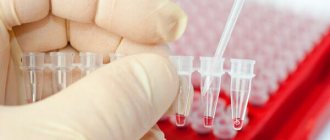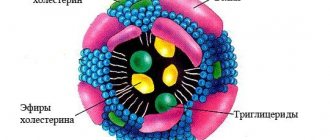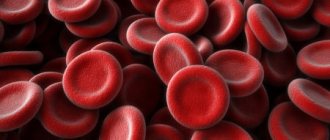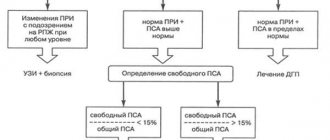When calcitonin is elevated
Any even slight increase in calcitonin levels is a serious reason for an in-depth examination of the patient by specialists experienced in the diagnosis and treatment of C-cell carcinoma.
It is believed that the probability of medullary cancer with calcitonin concentrations above 100 pg/ml is close to 100%. There is a direct connection between the degree of increase in this hormone and the stage of cancer, as well as the presence or absence of distant metastases.
If, according to the results of a fine-needle biopsy, the nodes in the thyroid gland are benign, but the level of the hormone is elevated, the second analysis has an advantage, since the likelihood that the results of the study are erroneous is very small. If the upper limit of normal is significantly exceeded (more than 100 pg/ml), the patient’s thyroid gland and all nearby lymph nodes are completely removed to exclude the presence of regional metastases. Therefore, the determination of calcitonin is a very serious analysis, and its results must be as accurate as possible.
It should be noted that hereditary predisposition contributes to the occurrence of medullary cancer. In nearly 50% of cases of people who have C-cell carcinoma, their children also get the disease. Sometimes the thyroid gland has to be removed in children aged 5-7 years or even younger to prevent the growth of malignant cells. In such cases, even the slightest increase in calcitonin indicates that the doctor is doing everything correctly.
There are difficult situations when the hormone level exceeds the norm slightly, i.e. below 100 pg/ml, but above the upper limit of normal values. This result can indicate either a very small tumor or its absence. In any case of elevated hormone levels, you must contact a specialized endocrinology center for additional research.
These may include:
- Fine-needle puncture of the node with histological analysis of the tumor and determination of calcitonin in the washout from the needle;
- Stimulated test with the study of calcitonin in the blood after the administration of calcium gluconate.
The information described above allows us to derive the following points:
- Calcitonin is a tumor marker used to diagnose medullary cancer;
- A blood test for the hormone calcitonin must be taken in all patients with nodules in the thyroid gland;
- The analysis should be taken in a specialized laboratory that conducts research on a third-generation chemiluminescent analyzer;
- Any increase in the level of calcitonin in the blood should be a reason to contact a specialized endocrinology center.
Author of the article:
Education: Diploma from Russian State Medical University named after. N.I. Pirogov, specialty “General Medicine” (2004). Residency at the Moscow State Medical and Dental University, diploma in Endocrinology (2006).
‹
Regimen for taking medicinal herbs for any female diseases (basics of herbal medicine)
7 mistakes that cause the tonometer to overestimate blood pressure readings
›
What to do if the result is increased or decreased?
By itself, a blood test for calcitonin, even with an unsatisfactory result, is not equivalent to the diagnosis and, most likely, will require additional diagnostic examinations if the results turn out to be overestimated or underestimated in comparison with the normative ones.
And yet, serious deviations from the norm suggest that the woman has serious diseases - perhaps even cancer.
If the level of calcitonin in the blood is elevated
Such a deviation may indicate the following diseases:
- Thyroid cancer;
- Respiratory cancer;
- Benign tumors in the lungs in the acute period;
- Breast cancer;
- Endometrial hyperplasia - proliferation of the uterine mucosa;
- Anemia – low hemoglobin in the blood;
- Pancreatitis – inflammation of the pancreas;
- Impairments in the functioning of the kidneys and/or liver;
- Thyroiditis is inflammation of the thyroid gland.
The most unpleasant and alarming diagnosis resulting from an elevated calcitonin level is, of course, thyroid cancer. The tumor develops slowly in it, but, unfortunately, in most cases it metastasizes. The development of the disease can be prevented at an early stage by removing the thyroid gland.
But based on just a slight increase in calcitonin, you should not draw conclusions about the presence of such a disease: firstly, with thyroid cancer, the levels of this hormone are significantly, and not slightly, increased compared to the norm, and secondly, thyroid cancer – the disease, so to speak, is “family”: a woman’s risk of occurrence is high only in a situation where this diagnosis was made to her blood relatives.
In this case, it is recommended to periodically take a calcitonin test in order to recognize the onset of the disease in time if it suddenly becomes inherited.
Separately, you need to pay attention to cases where, after cancer treatment, a calcitonin test still shows an elevated result relative to the norm. The situations may be as follows.
- As a result of surgery, the malignant tumor was removed. However, over time, a blood test for calcitonin did not show results within normal limits. This means that by the time the tumor was removed, it had already metastasized.
- If, after cancer treatment, the calcitonin level suddenly increases sharply, this may indicate a relapse of the disease.
If the level of calcitonin in the blood is low
A significant decrease in calcitonin in the blood may indicate the following changes in the body:
- Osteoporosis;
- Decrease in hormonal levels in general;
- Strong, excessive physical stress;
- Severe and frequent fatigue;
- Age-related changes in the body;
- Lack of calcitriol, an active form of vitamin D that promotes the absorption of calcium and phosphorus;
- Hypoparathyroidism – excessive production of parathyroid hormone;
- Mental retardation, cretinism.
Often, a decrease in calcitonin is a consequence of removal of the thyroid gland. In general, it must be said that a lower calcitonin level after oncology treatment may indicate that the treatment was prescribed correctly and the disease is being overcome.
So, calcitonin is a hormone that is actively involved in calcium-phosphorus metabolism and is an oncological marker for thyroid cancer and benign tumors in the lungs (in the acute period of the disease). When submitting an analysis, you should clarify which method - ELISA or CLIA - the laboratory uses. There is no need to engage in self-assessment and self-diagnosis: if the level of calcitonin in the blood increases or decreases, you should contact a competent endocrinologist.
The course of the calcitonin test and the rules for preparing for it
In order to determine the concentration of calcitonin in the blood, blood is drawn. The process looks like this and includes the following steps:
- After venipuncture has been performed, the material is placed in a sterile empty tube. It is also possible that a specialized gel is present in the test tube.
- The sample is sent into the cold, but the material must not be allowed to freeze. While in a portable thermal container, the blood is transferred to the laboratory.
- In the laboratory, whole blood is placed in a centrifuge and the serum is separated.
- The resulting material is analyzed using specific equipment and reagents. The results of the reaction are noted down and transferred to the patient for further review and transfer to the attending physician.
The need to take a hormonal test means strict adherence to medical recommendations for preparing for it.
The main points of preparation that will allow you to obtain true indicators of blood enzyme concentration are the following:
- A calcitonin sample is taken on an empty stomach. The last meal can be taken the night before, but no less than 8 hours before the actual test. An interval of 8-12 hours is considered ideal. Fasting time should not exceed 14 hours.
- If it is necessary to take a calcitonin test, the patient must refrain from consuming alcoholic beverages - the interval between the last alcohol consumption and the test is at least 24 hours.
- One hour before the event you are required to stop smoking.
- It is advisable to refrain from sexual contact and active physical activity 2 days before the test.
- On the eve of taking the sample, it is necessary to avoid stressful situations and nervous tension.
As for the medical worker, the doctor is obliged to conduct an explanatory conversation with the patient, which consists of the following points:
- The physician needs to explain the need to take a certain test, describe the risks if it is refused, and also explain the difference between the methods used in laboratories and what their impact on the final result of the analysis is.
- The doctor informs the patient about some of the main points of the procedure, such as the collection of material from the vein, who should carry out the collection procedure and at what time the procedure should take place.
- The specialist informs the patient about what venipuncture is, and also describes its main stages - applying a tourniquet, puncture, sensations from the tourniquet and puncture of the vein.
- Inform that the test results will not be ready immediately, but only after 1-7 days from the moment the material was taken for analysis. The average cost of a study in Moscow is about 1000 rubles.
After the patient receives the answer, he must visit the attending physician, who will review the obtained values and, based on their results, will be able to assume, establish or confirm the diagnosis.
Hormone norm
The level of calcitonin in adults in the blood depends on gender, age, and laboratory techniques. There are 2 types of determining the level of thyrocalcitonin: ELISA and ELISA (enzyme-immunoenzyme and immunochemiluminescent). Their research indicators are different.
ELISA is more common. For example, the calcitonin norm for ELISA is as follows:
- in adult women of fertile age – 0.07-12.97 pg/ml (picogram – trillionth of a gram);
- adult men – 0.68-32.26 pg/ml;
- children – up to 79 pg/ml.
With ICHLA - calcitonin hormone (thyroid hormone) in women and girls - does not exceed 0-1.46 pmol/l; for adult men and boys – no more than 2.46 pmol/l. All this data is collected for the work of laboratory technicians in special tables.
Calcitonin for women: the norm is different in that it has no lower limit. Even if the blood serum contains zero levels of the hormone, this will be considered normal. An increase is a rise in numbers above the upper limit of normal.
The table of norms shows that there is no difference between girls and boys. The highest level of calcitonin (physiological) was observed in infants in the first 7 days of their life: 70-348 pg/ml; this comes from feeding on breast milk, when Ca is transmitted from the mother.
Calcitonin levels decrease with age, especially during menopause in women. Calcitonin may temporarily increase during pregnancy. Why? Because during gestation the background of hormones completely changes in the body and general standards are invalid here. Calcitonin in the blood becomes especially high before childbirth. The numbers also remain high during breastfeeding.
Calcitonin increases with hormone replacement therapy containing estrogen. After treatment, calcitonin levels in the blood return to normal on their own. Another reason for the increase is the consumption of alcohol and intravenous administration of calcium. Calcitonin levels are tested separately from other thyroid hormones in specialized diagnostic centers.
Useful video
Watch the video about thyroid hormones:
Similar articles
- Thyroid cancer: symptoms of early...
Although not so common, thyroid cancer occurs; the symptoms at the initial stage are often vague. The signs of early medullary, papillary, and follicular differ. The prognosis for women and men largely depends on the type and age. Read more - Autoimmune thyroiditis: what is scary about the disease...
Autoimmune thyroiditis occurs as a hereditary disease. The disease is scary because it destroys the thyroid gland. Symptoms of Hashimoto's goiter are not detected in the early stages. Chronic treatment in adults and children involves taking hormone replacement. Read more
- Itsenko Cushing's disease and syndrome: causes, symptoms...
Many people confuse the disease and Itsenko-Cushing syndrome, but their causes are different, and so is their treatment. Symptoms manifest themselves externally, with interruptions in the functioning of all organs. Diagnosis is complex, the prognosis is not always favorable, even in children. Read more
- Radioiodine therapy of the thyroid gland: indications...
A fairly safe method of treatment even if cancer is detected is radioiodine therapy of the thyroid gland. The indications for use are quite extensive and can complement treatment after removal. Consequences and complications are extremely rare. What is better - surgery or radioiodine therapy? Read more
- Melatonin is the hormone of sleep, youth, long life...
It is believed that melatonin is the hormone of sleep, youth, and long life. Its properties resist cancer cells and reduce the negative impact on blood vessels. Production by the pineal gland is important for the normal functioning of the body. A deficiency is just as dangerous as an excess. Read more
Structure and functions of the hormone
Calcitonin (hormone calcitonin) - what is it? This is a peptide hormone consisting of 32 amino acid units. 8 sources (from animals) of calcitonin have been identified, but 3 have received medical significance and are used: thyrocalcitonin thyroid gland from salmon, pigs and humans.
The functions of calcitonin are such that, in addition to its main control over the levels of Ca and P, the hormone performs:
- regulation of calcium absorption in the intestine, and therefore reduces it in the blood serum;
- participates in the production of vitamin D;
- increases daily urination due to the excretion of sodium ions and uric acid;
- has a slight anti-inflammatory effect;
- reduces the secretion of hydrochloric acid in the stomach;
- the level of phosphorus in the blood decreases slightly.
The mechanism of the hormone:
- Stimulates the functional activity of osteoblasts, helping to form bone tissue;
- Calcitonin blocks the absorption of Ca in the intestine;
- Inhibits Ca reabsorption (reabsorption of calcium from primary urine) in the kidney tubules and removes it with urine.
- Thyroid calcitonin inhibits the functioning of osteoclasts; Unlike osteoblasts, they can resorb the mineral component of bone tissue.
Table with calcitonin norms for women and men
The generally accepted unit of measurement for the value under consideration is pg/ml (picograms per milliliter).
The normal levels of calcitonin in the blood for women and men are presented in the table below.
| Serum calcitonin | Normal values |
| Woman | Not more than 6.5 pg/ml |
| man | Not more than 9.4 pg/ml |
It should be emphasized that if repeated tests for calcitonin are necessary, it is recommended to contact the same laboratory. This will eliminate the discrepancy between the obtained analysis data due to the error of the measuring instruments.
Despite the ease of interpreting a laboratory indicator, you should not do it yourself. The doctor collects a comprehensive picture of the patient’s health status. It includes the patient’s history, clinical symptoms and complaints, as well as laboratory and other diagnostic data.
Indications for use
Application:
Systemic diseases with skeletal restructuring (Paget's disease, osteogenesis imperfecta, spontaneous bone resorption, aseptic necrosis of the femoral head); osteoporosis (postmenopausal, senile, steroid, parathyroid, etc.), fibrous dysplasia, traumatic bone damage with a complicated course of the repair process (slow healing of fractures); osteomyelitis (traumatic, radiation), zonal pathological reorganization of bones in athletes, periodontal disease, Sudeck syndrome, familial hyperphosphatemia, hypercalcemia of various origins (including idiopathic hypercalcemia of newborns), thyrotoxicosis, myeloma, bone metastases, hypervitaminosis D, prevention of bone disorders in as a result of prolonged immobilization; bone pain associated with osteolysis and/or osteopenia; acute pancreatitis (as part of combination therapy).
The norm and its excess
The norm of calcitonin in men and women is different; in women it should be within 5.0 ng/l, and in men – up to 8.4 ng/l. It is also important to remember that each laboratory equipment may determine the results differently, so the standards may have different indicators.
In medical practice, a calcitonin test is carried out to diagnose a medullary malignant tumor of the thyroid gland. This rather serious disease is hereditary in nature and is very often diagnosed in very young children. With this disease, this indicator increases sharply. Moreover, if after surgery the CT scan is higher than normal or even increases, then the treatment is ineffective and the disease progresses.
In addition to the fact that a CT scan is necessary to detect medullary cancer of the gland, it is also carried out to determine calcium metabolism along with a test for parathyroid hormone.
Calcitonin may also be higher than normal for the following indications:
- Various lung tumors, non-malignant.
- Kidney failure.
- Acute pancreatitis (inflammation of the pancreas).
- Increased function of the parathyroid glands, which are located on the posterior wall of the thyroid gland.
- Anemia caused by a lack of vitamin B12.
- Certain chronic bone diseases involving bone tissue.
- Malignant formations of internal organs.
There are situations when an increase in this standard is associated with the following conditions:
- Pregnancy in women.
- Children at birth.
- Sex hormone therapy.
- Intravenous calcium administration.
- Drinking alcoholic beverages.
You should know that when calcitonin increases, the remaining thyroid hormones remain normal and perform their function.
In order to obtain correct analysis results during the examination, you must adhere to certain rules. Before taking tests, both women and representatives of the stronger sex need to exclude physical overload, stressful situations, and it is advisable not to overeat or drink alcoholic beverages. Women are also advised to take contraceptives. The most suitable time for examination is the morning.
What is calcitonin?
Calcitonin is a thyroid hormone that is produced by special C cells. These cells are often located near the follicles, which is why they were previously called parafollicular cells. C-cells are of neuroendocrine origin and are formed in the pancreas during the intrauterine development of the human body. Calcitonin synthesis is the main function of C cells.
The functions of calcitonin are not yet fully understood; this distinguishes it from other thyroid hormones. The number of C-cells that secrete calcitonin is significantly less than the B- and C-cells included in the follicles of the gland. While the T3 and T4 hormones are tested to determine organ function, the blood calcitonin value is used for other purposes.
In various textbooks and manuals, the hormone calcitonin is considered an antagonist of parathyroid hormone, a product of the parathyroid (or parathyroid) glands. The importance of parathyroid hormone lies in the activation of special cells - osteoclasts. The latter, under the influence of this hormone, destroy bone tissue, as a result of which calcium is released from it and enters the blood. Another function of the parathyroid hormone is to enhance the reabsorption of calcium ions in the kidney tubules from primary urine. Parathyroid hormone also stimulates the conversion of vitamin D into its active form, calcitriol, which ensures the transport of calcium ions from the small intestine to the blood. Thus, the end result of the activity of parathyroid hormone is an increase in the level of calcium in the plasma, and calcitonin has the opposite effect.
In terms of its activity, calcitonin is much weaker than parathyroid hormone; therefore, it cannot be argued that calcium metabolism in the body is regulated only by these two hormones. In this complex process, in addition to parathyroid hormone and calcitonin, vitamin D and many other compounds take part.
C-cells of the thyroid gland synthesize calcitonin in very small quantities, so its concentration in the blood is normally very low. This hormone can also be produced in small amounts in the intestines. In this article we will consider calcitonin as a tumor marker, which is used in the diagnosis of a dangerous tumor from the thyroid tissue - medullary cancer.
Conditions in which calcitonin is elevated
Diseases characterized by elevated levels of the hormone include:
- thyroid C-cell hyperplasia;
- medullary thyroid cancer;
- breast, prostate, lung cancer;
- Zollinger-Ellison syndrome;
- pheochromocytoma;
- carcinoid syndrome;
- myeloproliferative diseases, leukemia;
- pseudohypoparathyroidism (Albright's hereditary osteodystrophy);
- thyroiditis;
- chronic renal failure;
- uremia;
- pernicious anemia;
- chronic inflammatory diseases;
- alcoholic cirrhosis of the liver.
Since medullary cancer grows from cells that secrete calcitonin, its level in the blood increases significantly already in the early stages of the disease.
The concentration of calcitonin increases during pregnancy, with the use of calcium supplements, estrogens, and with an overdose of vitamin D.
Video from YouTube on the topic of the article:
Blood test for calcitonin
The concentration of calcitonin can now be determined in many laboratories, which use various equipment for this purpose. The most reliable information about the content of this hormone can be obtained using 3rd generation analyzers based on the immunochemiluminescent method. More common 2nd generation analyzers using enzyme immunoassay methods are cheaper, but have a serious drawback - a significant error in the result. Their use may lead to inaccuracies in the diagnosis and subsequent treatment of patients.
A very dangerous malignant tumor, C-cell carcinoma, or medullary cancer, can develop from the C-cells of thyroid follicles. A feature of this tumor is its relatively slow but steady growth. Over time, medullary cancer metastasizes to the lymph nodes located in the neck and mediastinum; through the bloodstream, metastases can also reach the lungs, liver, bones and even the brain. Treatment of C-cell carcinoma presents significant difficulties, since the tumor does not respond to antitumor chemotherapy drugs and radiation therapy. Only antitumor agents based on kinase inhibitors can have a minor effect on C-cell carcinoma. The only effective treatment for this type of cancer is surgery in the early stages of the process. This is the only way that gives a chance for recovery if cancer is diagnosed early.
Since C-cell carcinoma grows from cells that secrete calcitonin, its content in the blood increases sharply already in the early stages of cancer. This is why the content of this hormone is of such interest to endocrinologists and surgeons. Calcitonin concentration testing is the most reliable and early method for determining medullary cancer, which allows saving more than one thousand human lives.
Every year, approximately 100-150 new cases of C-cell thyroid carcinoma are registered throughout Russia. Statistical studies have shown that in 16 densely populated regions of the European part of Russia, about 40 diagnoses of medullary cancer are made per year.
Among all cases of thyroid tumors, the most dangerous are the anaplastic and medullary forms. While effective treatment methods have not yet been developed for anaplastic cancer, C-cell carcinoma is completely curable if diagnosed early. And only a blood test for calcitonin can help with this.
In 2012, the European Thyroid Association added to its recommendations an indication of the need for a single determination of calcitonin in all patients with nodules in the thyroid gland. This analysis does not have to be performed every year; a repeat study in the case of the first normal result is prescribed only if new nodes have been registered.
This fact has led the European endocrine community to believe that the financial costs of conducting 300 studies will be justified if at least one of them reveals the presence of medullary cancer. At the same time, the American Thyroid Association still believes that such a massive scale of calcitonin research is not economically justified. This concerns only the financial part of the issue; no one doubts the clinical value of this method.
About the hormone
In most medical textbooks, it is considered to be a kind of antagonist of parathyroid hormone, which is synthesized by the cells of the parathyroid glands. Parathyroid hormone triggers the action of special cells - osteclasts, which cause the destruction of bones and remove calcium from them into the blood. Other properties of the hormone are reduced to increased absorption of calcium from urine and to the formation of calcirol, which helps better absorption of the element from the gastrointestinal tract. That is, the functions of parathyroid hormone are reduced to increasing the level of calcium in the blood. The hormone calcitonin, in a certain way, “counteracts” parathyroid hormone, helping to deposit the element in the bones, and therefore reducing its concentration in the blood.
Nevertheless, in its effects it is weaker than parathyroid hormone. In addition, once in the blood fluid, it disintegrates quickly (half-life ranges from 2 to 15 minutes). That is why it is not correct to say that calcium balance is ensured purely by the balance of calcitonin and parathyroid hormone. It should be noted: parathyroid hormone, if introduced into the body in small dosages at intervals, will also enhance the deposition of the element in the bones. Therefore, it is more correct to think that calcium metabolism is a complex process in which calcitonin, parathyroid hormone, vitamin D and other substances are involved.
If there is an imbalance in this balance, in particular when doctors suspect primary osteoporosis, the person is asked to undergo a test to measure hormone levels, as well as to study other markers of bone remodeling. As a rule, primary osteoporosis is associated with a decrease in normal calcitonin levels. However, if a person has secondary osteoporosis, in this case the level of calcitonin does not decrease.
However, the test indicators are especially important for detecting thyroid cancer and identifying multiple endocrine neoplasia syndrome, which manifests itself as medullary cancer, pheochromocytoma, parathyroid hyperplasia, and hyperparathyroidism. It should be noted that the thyroid gland produces small amounts of calcitonin, so there cannot be a lot of it. Of course, it is produced in the intestines, but these quantities are completely miniscule.
Symptoms of increased calcitonin
First signs:
- the timbre of the voice changes;
- dysphagia;
- breathing becomes difficult at times;
- pain at the site of the tumor and visual changes in the neck;
- enlarged lymph nodes, the appearance of metastases.
A calcitonin level above 100 pg/ml indicates the need for surgical treatment. Most often, total excision of the entire gland with lymph nodes is performed. What does elevated thyrocalcitonin indicate? If the excess does not go beyond the upper limit of the norm, you often just need to reconsider your work and rest schedule, establish proper sleep and a balanced diet.
Sometimes tests show a calcitonin value of 2.00. This indicator is not considered high, since the normal level of a hormone such as calcitonin in women, 2.00 pg/ml, fits into the existing specified range in the table.
With an age-related decrease in calcitonin, if there are no contraindications, its level can be supported by taking medications and increased, but treatment should only be prescribed by a doctor.
Myxedema. Cretinism. Calcitonin and parathyroid hormone.
Myxedema. Cretinism. Calcitonin and parathyroid hormone.
Reasons for the increase
There are many reasons why this hormone in the blood may have an increased value. If such a deviation is detected, the doctor prescribes further examinations to make a final diagnosis.
Article on the topic:
What is DHEA-S hormone? Tests and normal values in women
Possible reasons that may cause increased calcitonin in women:
- The most negative option is thyroid cancer. But it is not the most important or most common reason on the list.
- Benign tumors that arise in the lungs. In this case, calcitonin may increase during an exacerbation.
- Oncological neoplasms in the respiratory organs.
- Mammary cancer.
- Anemia, or low hemoglobin levels. If there is such a reason and no others, this option is the most favorable.
- An inflammatory process in the pancreas – pancreatitis. If left untreated, it can develop into pancreatic necrosis, a disease with a possible fatal outcome. But pancreatitis, if the doctor’s instructions are followed and treated in a timely manner, does not pose a serious danger.
- Liver or kidney problems.
- Thyroiditis. This is an inflammatory process that occurs inside the thyroid gland.
- Women may experience endometrial hyperplasia. This is the process of growth of the uterine mucosa.
Patients should not panic based on the results of testing for this hormone alone. As can be seen from the list, the reasons may even lie in low iron levels in the blood.
Those who have already been diagnosed and treated for thyroid cancer need to urgently undergo additional examinations. Deviations from the norm may mean that before the tumor was removed, it had time to metastasize or a relapse occurred.
In other cases, examinations should be completed in the coming weeks. It is better not to delay for longer than a month; Ideally, follow your doctor's instructions, including dates.











